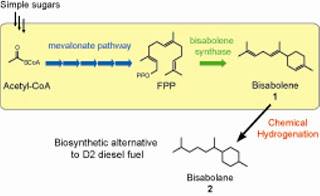Researchers with the U.S Department of Energy (DOE)’s Joint BioEnergy Institute (JBEI) have identified a potential new advanced biofuel that could replace today’s standard fuel for diesel engines but would be clean, green, renewable and produced in the United States. Using the tools of synthetic biology, a JBEI research team engineered strains of two microbes, a bacteria and a yeast, to produce a precursor to bisabolane, a member of the terpene class of chemical compounds that are found in plants and used in fragrances and flavorings. Preliminary tests by the team showed that bisabolane’s properties make it a promising biosynthetic alternative to Number 2 (D2) diesel fuel.
Commercial trucks in the U.S. burned approximately 22 billion gallons of diesel fuel in 2010. Replacing diesel with a clean, green and renewable biofuel could substantially reduce the industry’s carbon footprint. (Dept. of Transportation)
This diagram shows the steps for synthesizing bisabolane, an alternative to D2 diesel, from the chemical hydrogenation of bisabolene, which is metabolized in microbes via an engineered mevalonate pathway, (Image from Taek Soon Lee)
“This is the first report of bisabolane as a biosynthetic alternative to D2 diesel, and the first microbial overproduction of bisabolene in Escherichia coli and Saccharomyces cerevisiae,” says Taek Soon Lee, who directs JBEI’s metabolic engineering program and is a project scientist with Lawrence Berkeley National Laboratory (Berkeley Lab)’s Physical Biosciences Division. “This work is also a proof-of-principle for advanced biofuels research in that we’ve shown that we can design a biofuel target, evaluate this fuel target, and produce the fuel with microbes that we’ve engineered.”
Lee is the corresponding author of a paper reporting this research in the journal Nature Communications entitled “Identification and microbial production of a terpene-based advanced biofuel.” Co-authoring this paper were Pamela Peralta-Yahya, Mario Ouellet, Rossana Chan, Aindrila Mukhopadhyay and Jay Keasling.
The rising costs and growing dependence upon foreign sources of petroleum-based fuels, coupled with scientific fears over how the burning of these fuels impacts global climate, are driving the search for carbon-neutral renewable alternatives. Advanced biofuels – liquid transportation fuels derived from the cellulosic biomass of perennial grasses and other non-food plants, as well as from agricultural waste – are highly touted for their potential to replace gasoline, diesel and jet fuels. Unlike ethanol, which can only be used in limited amounts in gasoline engines and can’t be used at all in diesel or jet engines, plus would corrode existing oil pipelines and tanks, advanced biofuels are drop-in fuels compatible with today’s engines, and delivery and storage infrastructures.
“We desperately need drop-in, renewable biofuels that can directly replace petroleum-derived fuels, particularly for vehicles that cannot be electrified,” says co-author Keasling, CEO of JBEI and a leading authority on advanced biofuels. “The technology we describe in our Nature Communications paper is a significant advance in that direction.”
“Bisabolane has properties almost identical to D2 diesel but its branched and cyclic chemical structure gives it much lower freezing and cloud points, which should be advantageous for use as a fuel,” Lee says. “Once we confirmed that bisabolane could be a good fuel, we designed a mevalonate pathway to produce the precursor, bisabolene. This was basically the same platform used to produce the anti-malarial drug artemisinin except that we introduced a terpene synthase and further engineered the pathway to improve the bisabolene yield both in E. coli and yeast.”
Lee and his colleagues are now preparing to make gallons of bisabolane for tests in actual diesel engines, using the new fermentation facilities at Berkeley Lab’s Advanced Biofuels Process Demonstration Unit. The ABPDU is a 15,000 square-foot state-of-the art facility, located in Emeryville, California, designed to help expedite the commercialization of advanced next-generation biofuels by providing industry-scale test beds for discoveries made in the laboratory.
“Once the complete fuel properties of hydrogenated biosynthetic bisabolene can be obtained, we’ll be able to do an economic analysis that takes into consideration production variables such as the cost and type of feedstock, biomass depolymerization method, and the microbial yield of biofuel,” Lee says. “We will also be able to estimate the impact of byproducts present in the hydrogenated commercial bisabolene, such as farnesane and aromatized bisabolene.”
Ultimately, Lee and his colleagues would like to replace the chemical processing step of bisabolene hydrogenation with an alkene reductase enzyme engineered into the E.coli and yeast so that all of the chemistry is performed within the microbes.
“Enzymatic hydrogenation of this type of molecule is a very challenging project and will be a long term goal,” Lee says. “Our near-term goal is to develop strains of E.coli and yeast for use in commercial-scale fermenters. Also, we will be investigating the use of sugars from biomass as a source of carbon for producing bisabolene.”
If you liked this article, please give it a quick review on ycombinator or StumbleUpon. Thanks

Brian Wang is a Futurist Thought Leader and a popular Science blogger with 1 million readers per month. His blog Nextbigfuture.com is ranked #1 Science News Blog. It covers many disruptive technology and trends including Space, Robotics, Artificial Intelligence, Medicine, Anti-aging Biotechnology, and Nanotechnology.
Known for identifying cutting edge technologies, he is currently a Co-Founder of a startup and fundraiser for high potential early-stage companies. He is the Head of Research for Allocations for deep technology investments and an Angel Investor at Space Angels.
A frequent speaker at corporations, he has been a TEDx speaker, a Singularity University speaker and guest at numerous interviews for radio and podcasts. He is open to public speaking and advising engagements.


